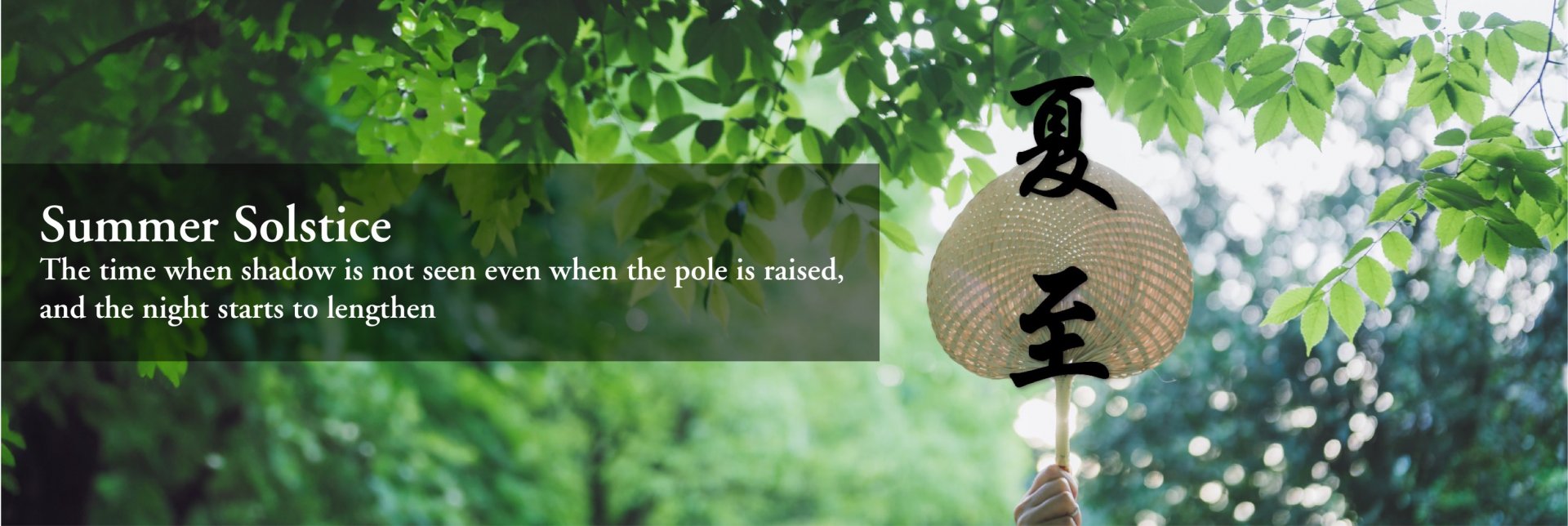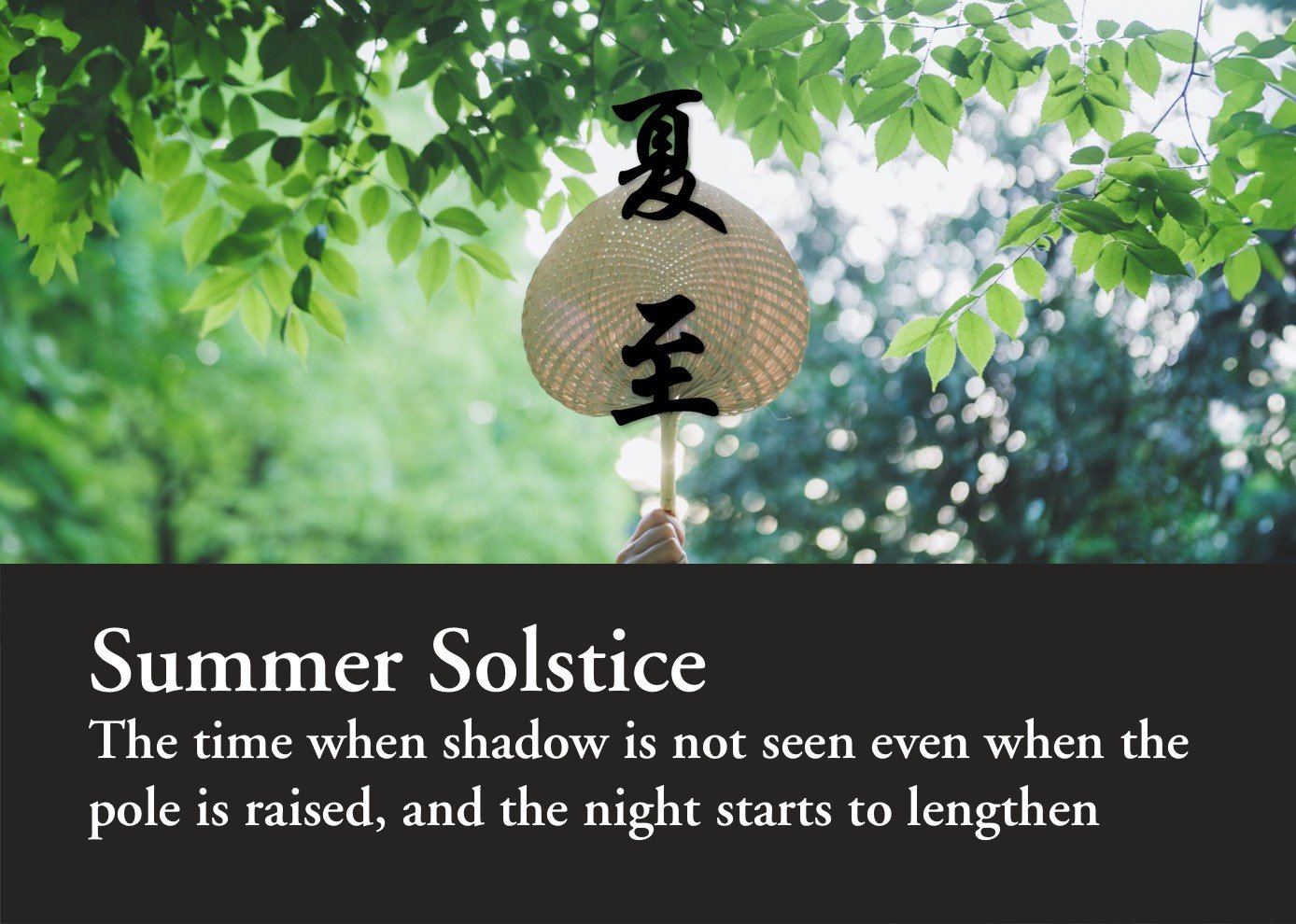Summer Solstice :
The time when shadow is not seen even when the pole is raised, and the night starts to lengthen
“Set up a pole and a shadow is formed immediately” (立竿見影), a proverb that remains popular through the test of time, is a metaphor to describe an action immediately brings good results. However, in social reality, “raising a pole” does not always lead to “forming a shadow” – this even applies to the natural phenomena. It seems to be the law of nature that whenever sunlight is present, there will be shadows. In line 3 of the poem Body, Shadow and Spirit (形影神) written by Tao Yuanming (陶洲明,365-427), it says, “If I have left you in the shade, I’ll appear again in sunshine (憩蔭若暫乖,止日終不別)”. This means that if one stays in the shade of a tree, one’s own shadow will be temporarily “separated”. On the contrary, once one stands under the sun, one’s own shadow will eventually come back. Nevertheless, astronomy tells us that if the sun shines vertically on the earth’s surface, the shadow of a vertical object is right below the base - as if it has disappeared.
Throughout the four seasons in a year, there are circumstances that “raising a pole” may not lead to “forming a shadow”: First, the sun shines vertically overhead at the Equator (赤道) on the Spring Equinox (春分) and the Autumnal Equinox (秋分). Second, the sun is overhead on the Tropic of Capricon (南回歸線) on the Winter Solstice (冬至). Third, the sun is overhead on the Tropic of Cancer (北回歸線) on the Summer Solstice (夏至). The Tropic of Cancer crosses the areas of Guangdong, Guangxi and Yuannan. On the Summer Solstice every year, the shadow under the sun disappears at noon. Guangdong Province is where the most Tropic of Cancer sign towers are built in the world. One of them is the Guangzhou Signage Tower of the Tropic of Cancer in Conghua District (從化區南回歸線標誌塔), which is the tallest and biggest among similar leagues in the world, is an attraction for astronomy lovers to witness the “no-shadow” spectacle in the Summer Solstice.

The Tropic of Cancer is the most northerly circle of latitude on Earth at which the Sun can be directly overhead. This matches the idea of Xiazhi (夏至) in traditional Chinese calendar. Here, “Xia” (夏, summer) and “Zhi” (至) do not mean that “summer” is “coming” (which is the usual translation of the character Zhi 至), but carry the meaning that “summer” is “at its extreme”. Therefore, there is an old saying, “When the Sun arrives at the north, the day is the longest and the shadow is the shortest. That’s why it is called Xiàzhì (夏至). Zhì(至) means that the summer is at its extreme (日北至,日長之至,日影短至,故曰夏至。至者,極也。)”. This old saying described why the Summer Solstrice is “the most extreme” in three levels: First, the Sun seems to be located at the highest point in the northern hemisphere. Second, it is the moment when the northern hemisphere of the Earth is having the longest daytime and the longest time in sunshine. Third, as the sun its shining directly overhead, which does not tilt, the shadow is becoming the shortest, particularly at noon when the sun is directly overhead. This leads to the phenomenon that the shadow is directly overlapping with the object itself, as if the shadow has “silently disappeared”.
Under the system of Twenty-Four Solar Terms, the Summer Solstice marks the beginning of the midsummer. Here is the evidence: after the Summer Solstice, the daytime in the northern hemisphere gradually shortens and the night gradually lengthens. In line one of poem Shelter From Heat in Bei Chi on the Summer Solstice (夏至避暑北池) written by Wei Yingwu (韋應物,737-791), it says “On the day of the Summer Solstice, the daytime measured by the gnomon has reached its extreme. After that, the nighttime measured by the clepsydra gradually increases (晝晷已云極,宵漏自此長)”. Another piece of evidence is that while the Summer Solstice is not the hottest day in the year, it is becoming hotter and hotter afterwards, marking the arrival of the hot midsummer – the hottest period of the year. A proverb says, “Three Geng-days after the day of the Summer Solstice is the first Fu day (夏至三庚數頭伏)”. This means that three cycles of Geng (庚) days after the Summer Solstice, the hottest day (Chinese called this three Fu days, 三伏天, which is equivalent to Dog days in its Western counterpart) arrives. Here are some explanations. Ancient Chinese used Heavenly Stems (Tiangan, 天干) and Terrestrial Branches (Dizhi, 地支) to form Sexagenary Cycle, which is the cycle for counting days in lunar calendar. There are ten heavenly stems, namely Jia (甲), Yi (乙), Bing (丙), Ding (丁), Wu (戊),Ji (己), Geng (庚), Xin (辛), Ren (壬), and Gui (癸). Taking 2023 as an example, the Summer Solstice is on the 21st of June. In Chinese lunar calendar, this is the fourth day of the fifth month of the year of Gui-mao (癸卯, the fourtieth term of the Sexagenary Cycle). That is counted as Geng-xu day (庚戌), which is the first “Geng” day. The second “Geng” day is ten days after, which is Geng-Shen day (庚申) on the 1st of July. The third “Geng” day is ten days after, which is Geng-wu (庚午) on the 11th of July. Therefore, the first Sanfu (三伏, three hottest days) in the summer starts 11th of July.
The Summer Solstice is the beginning of the midsummer, there is another important feature that “Yang qi” (陽氣, the masculine Qi, here “Qi” could be regarded as the flow of natural energy) is at its fullest, and the “Yin qi” (陰氣, the feminie Qi) begins to recover. This is what Ancient Chinese described as “the starting point of the revival of the Yin” (Yiyinsheng, 一陰生). It was written in a poem Homesick when I just assume the office as an Editor in the Royal Academy (思歸時初為校書郎) by Bai Juyi (白居易 772-846) that “After the day of the Summer Solstice when Yin Qi begins its revival, the signal of the beginning of the day comes slightly after”. (夏至一陰生,稍稍夕漏遲). Ancient Chinese found that, since the arrival of the Summer Solstice, there are three natural phenomena that could represent the rise and decline of the Yin and Yang Qi. The first phenomenon is Lujiaojie (Deer Horns Falling Off). Here Jie (解) means falling off. Ancient Chinese believed that deer horn is a symbol of “Yang” (masculine) as it is facing the front. As the day of the Summer Solstice symbolizes the summit of Yang Qi and the revival of Yin Qi, deer horns fall off to adapt to the change in the flow of the nature. The second phenomenon is Chanshiming (蟬始鳴, Cicadas begin to sing). In Chinese belief, the male cicada is a symbol of Yang, the chirping and fluttering of cicadas are believed to be the response of male cicadas to the rise of the Yin Qi. One should note that there is a vast number of species of cicadas. In this paragraph, we are referring to the summer cicada (Xiachan, 夏蟬), which is mentioned in a poem The Seventh Month in The Book of Songs (Also translated as Book of Odes or Shi King) (詩經‧七月), “In the fifth month, the cicada gives out its note.” (五月鳴蜩). This only applies to the summer cicadas, but not the spring cicadas and autumn cicadas which chirp in their corresponding seasons. The third phenomenon is Banxia Sheng (半夏生, Crow-dipper Blossoms. The term Banxia (半夏) refers to a herb (In English it is known as Chinese Lizard Tail Plant), the name itself is already associated with the midsummer (Ban means “half”, Xia means “summer”). We should note that Banxia does not sprout in midsummer, but the term Sheng (生) here means that this plant, which loves Yin Qi, fully develops and blooms in midsummer.

As the Summer Solstice marks the beginning of various astrological, natural, and agricultural phenomena, it was highly regarded in ancient times, and it was hailed as one of the most important eight solar terms through out the four seasons (四時八節). In Rites of Zhou: Spring Offices headed by the Overseer of Ritual Affairs (周禮‧春官), there were records of rituals to worship Earthly deities, gods and spirits of various plants and animals. Being at the top, “Heaven” is regarded as a representation of Yang, while being at the bottom, “Earth” is regarded as a representation of Yin. Therefore, at the time of Summer Solstice when Yin Qi begins to revive, people would worship Earthly deities as well as spirits and gods related to various plants and animals, with a wish to represent the respect and thankfulness to the gifts from the nature and Gods of crops to send food to the Earth. It is also an occasion to pray for a good adaptation to the change in weather and a good harvest, as well as to drive away mishaps and wish for good fortune.
In ancient times, no matter among the noble class or among the general public, there were many rituals and practices to celebrate the Summer Solstice. Before the Ming (1368-1644) and Qing Dynasty (1644-1911), the Summer Solstice was an important festival in which the government officials could enjoy holidays. From the historical records such as Tang Liudian (唐六典, The Six Statutatory Codes of the Tang Dynasty) and Tiashengling (天聖令, The Decrees Emperor Renzong of Song Dynasty), it was found that the government officials in Tang and Song Dynasty enjoyed three-day holidays on the Summer Solstice, which was a long-established tradition. As recorded Book of Han: Chapter on Biography of Xue Xuan (漢書‧薛宣傳), it was mentioned that the holiday for the government officials has “a very long history” since Han Dynasty. Therefore, in Book of Han, it was mentioned that during the vacation, the government officials “went home to meet with their wives and children, held banquets, invited their neighbours to the banquets and served them food and wine, had fun with each other with a smile” (歸對妻子,設酒肴,請鄰里,一笑相樂)”, so as to have quality time with family, friends and neighnours. In The History of the Southern Dynasties: Biography of Shen Linzi (南史‧沈林子傳), there was a record of the Shen clans member “meeting in a big assembly, the clansmen fill every chambers” (大集會, 子弟盈堂) on the grand celebration of the Summer Solstice in the fifth month in Lunar Calendar.
In modern times, the Summer Solstice is no longer regarded as a festival anymore, but the daily practices related to the Sumer Solstice still prevail. For example, there was an old practice in different parts of China to “eat dumplings in the Winter Solstice and eat noodles during Summer Solstice” (冬至餃子夏至麵). Nowadays, residents in North China region like Beijing and Shandong start to eat cold noodles as well as cold and raw food like lettuce to soothe discomfort due to heat stroke. The Summer Solstice comes right after Grain In Beard, when the wheat is harvested and grinded into flour for making noodles. These practices hence implicitly encourage one to taste these freshly prepared food.

The Beginning of Spring marks the beginning of a year, while the Summer Solstice marks the beginning of the midsummer. If Three Spring Months (San Chun, 三春) and Early Summer (Chuxia, 初夏) are comparable to the youth in human life, the midsummer could be comparable to the prime of life, when everyone endevours to succeed with hope to welcome the prosperous harvest in the golden autumn.
Reference:
Journal Article
1. 王永平:〈夏至節俗〉,《文史知識》,第6期(2022年)。
2. 王辰宇:〈中國古典詩詞與夏至節氣的人文之美〉,《名作欣賞》,第15期(2023年)。
3. 陳虎:〈古詩詞中的夏至節〉,《文史知識》,第8期(2019年)。
All articles/videos are prohibited from reproducing without the permission of the copyright holder.




Welcome to leave a message:
Please Sign In/Sign Up as a member and leave a message